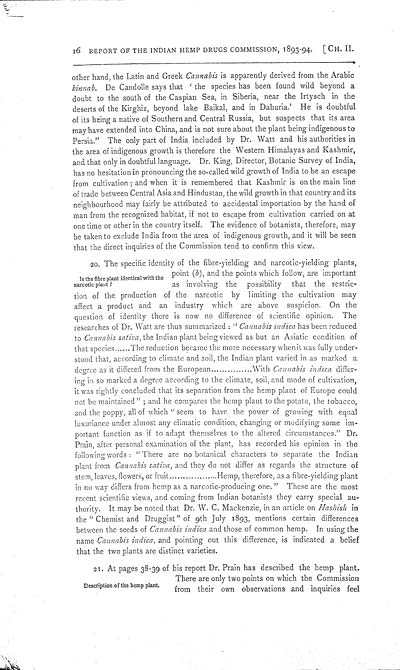Download files
Individual page:
Thumbnail gallery: Grid view | List view

16 REPORT OF THE INDIAN HEMP DRUGS COMMISSION, 1893-94. [CH. II.
other hand, the Latin and
Greek Cannabis is apparently derived from the Arabic
kinnab. De Candolle says that 'the species has been found
wild beyond a
doubt to the south of the Caspian Sea, in Siberia, near the Irtysch
in the
deserts of the Kirghiz, beyond lake Baikal, and in Dahuria.' He is
doubtful
of its being a native of Southern and Central Russia, but suspects
that its area
may have extended into China, and is not sure about the plant being
indigenous to
Persia." The only part of India included by Dr. Watt and his
authorities in
the area of indigenous growth is therefore the Western Himalayas
and Kashmir,
and that only in doubtful language. Dr. King, Director, Botanic
Survey of India,
has no hesitation in pronouncing the so-called wild growth of India
to be an escape
from cultivation; and when it is remembered that Kashmir is on the
main line
of trade between Central Asia and Hindustan, the wild growth in
that country and its
neighbourhood may fairly be attributed to accidental importation by
the hand of
man from the recognized habitat, if not to escape from cultivation
carried on at
one time or other in the country itself. The evidence of botanists,
therefore, may
be taken to exclude India from the area of indigenous growth, and
it will be seen
that the direct inquiries of the Commission tend to confirm this
view.
Is the fibre plant
identical with the
narcotic plant?
20. The specific identity
of the fibre-yielding and narcotic-yielding plants,
point (b), and the
points which follow, are important
as involving the possibility that the restric-
tion of the production of the narcotic by limiting the cultivation
may
affect a product and an industry which are above suspicion. On
the
question of identity there is now no difference of scientific
opinion. The
researches of Dr. Watt are thus summarized: "Cannabis indica
has been reduced
to Cannabis sativa, the Indian plant being viewed as but an
Asiatic condition of
that species......The reduction became the more necessary when it
was fully under-
stood that, according to climate and soil, the Indian plant varied
in as marked a
degree as it differed from the European............With Cannabis
indica differ-
ing in so marked a degree according to the climate, soil, and mode
of cultivation,
it was rightly concluded that its separation from the hemp plant of
Europe could
not be maintained"; and he compares the hemp plant to the potato,
the tobacco,
and the poppy, all of which "seem to have the power of growing with
equal
luxuriance under almost any climatic condition, changing or
modifying some im-
portant function as if to adapt themselves to the altered
circumstances." Dr.
Prain, after personal examination of the plant, has recorded his
opinion in the
following words: "There are no botanical characters to separate the
Indian
plant from Cannabis sativa, and they do not differ as
regards the structure of
stem, leaves, flowers, or
fruit ............Hemp, therefore, as a fibre-yielding
plant
in no way differs from hemp
as a narcotic-producing one." These are the most
recent scientific views, and coming from Indian botanists they
carry special au-
thority. It may be noted that Dr. W. C. Mackenzie, in an article on
Hashish in
the "Chemist and Druggist" of 9th July 1893, mentions certain
differences
between the seeds of Cannabis indica and those of common
hemp. In using the
name Cannabis indica, and pointing out this difference, is
indicated a belief
that the two plants are distinct varieties.
Description of the hemp plant.
21. At pages 38-39 of his
report Dr. Prain has described the hemp plant.
There are only two points on
which the Commission
from their own observations and inquiries feel
Set display mode to: Large image | Zoom image | Transcription
Images and transcriptions on this page, including medium image downloads, may be used under the Creative Commons Attribution 4.0 International Licence unless otherwise stated. ![]()
| India Papers > Medicine - Drugs > Report of the Indian Hemp Drugs Commission, 1894-1895 > Volume I > (34) Page 16 |
|---|
| Permanent URL | https://digital.nls.uk/74574136 |
|---|---|
| Description | Chapter II, cont. |
| Description | [Volume 1]: Report. |
|---|---|
| Attribution and copyright: |
|



![Page [15]](https://deriv.nls.uk/dcn4/7443/74434753.4.jpg)
![Plate [1]](https://deriv.nls.uk/dcn4/7443/74434755.4.jpg)